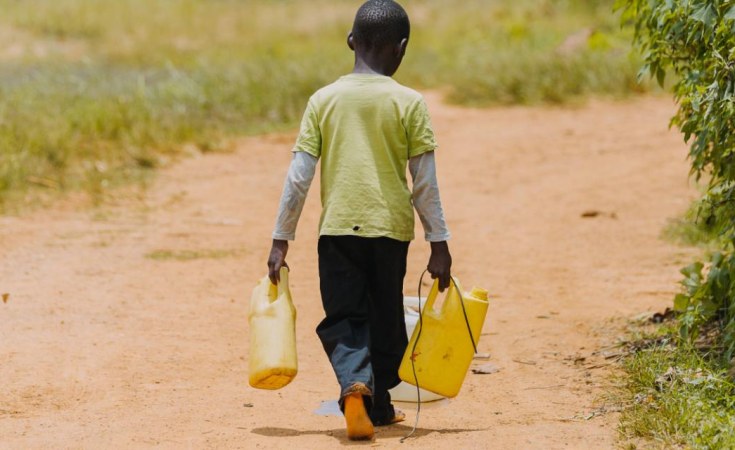Africa is at a crossroad. A convergence of crises – the COVID-19 pandemic, the Ukraine war along with climate change – have exacted a huge toll on the continent's development. The pandemic pushed 62 million non-poor Africans into poverty in 2020, and 149 million non-poor people (whose consumption was 20 per cent above the poverty line) were at risk of falling into poverty in 2022. Indeed, Africa is now home to more than half of the world's poor, and 546 million people are living in extreme poverty – yes, that's more than half of the continent's population.
These crises have set Africa's development back by decades and with much poorer economic performance going forward, prospects are only getting dimmer and require concerted policy intervention.
One thing to note is that poverty in Africa is primarily a Sub-Saharan Africa phenomenon and is largely concentrated in least developed countries (LDCs), while middle income countries have less than 5% of their population in poverty.

Figure 1: Poverty in Africa (2022)
Source: ECA computations based on World Bank data
While Africa's robust economic growth in the last two decades reduced poverty, its benefits were not equally accrued as inequality not only widened, but also remained pervasive across all sub-regions. Income and wealth inequalities are particularly stark in Southern Africa.
Figure 2: Wealth inequality in Africa by sub-region (2022)
Source: ECA computations based on World Bank data
These high rates of poverty and inequality have exacerbated the socio-economic conditions of the poor going forward. For instance, over 80% of the labor force works in the informal sector where they generally lack access to healthcare and other social schemes. Thanks to lockdowns during the pandemic, their earnings declined by 81 per cent in the first month of the pandemic (ILO), increasing their risk of slipping into poverty. The same holds for the majority of Africa's rural residents (an estimated 50 to 80 per cent according to the ILO) who cover their health expenses out of pocket, are being driven into poverty. Similarly, children from poor and vulnerable households were adversely affected by the pandemic as prolonged school closures in many countries left them without access to education. According to UNESCO, 98 million children in Africa were out of school in 2021, with girls whose school dropout rate was higher than for boys (4.2 vs. 3.1 percentage points, respectively), bearing the brunt.

Making the right turn to reduce poverty and inequality in Africa
As the clock is ticking on the 2030 Agenda, achieving SDG1 on eliminating poverty appears untenable. Moreover, growing poverty and rising inequality pose challenges to an increasingly fragile social contract that could fray under the weight of citizens' unfulfilled expectations while threatening the prospects for peace, security and prosperity. Taken together, these developments underscore the need to confront head on what are inarguably the continent's most pressing development challenges.

At the fifty-fifth session of the Economic Commission for Africa themed Fostering recovery and transformation in Africa to reduce inequalities and vulnerabilities, which takes place from March 15 – 21, 2023 in Addis Ababa, African Ministers of Finance, Planning and Economic Development will convene to deliberate these issues. The meeting provides an opportunity for policymakers to consider how to best tackle Africa's most pressing development challenges and ensure that benefits of development are more equitably distributed and accrue to all.
The task is daunting as shrinking fiscal space constrains governments' capacities to adequately respond to and meet citizens' needs. However, to effectively deliver on the social contract and accelerate the recovery from the crises' adverse effects, African governments need to take bold and decisive actions that ensure equal access to public goods as well as opportunities for all.
Policy measures that governments could consider include pursuing pro-poor and inclusive macro-economic policies, with spending targeted at safety nets to support the poor and most vulnerable. Ensuring resource mobilization for an inclusive recovery, including through fair taxes and by leveraging climate finance for decent job creation, is vital to tackling poverty and inequality. Carving a structural development path that is just and meets people's needs, with industrialization and the African Continental Free Trade Area (AfCFTA) acting as catalysts, can provide the impetus for structural transformation that contributes to an economic recovery that leaves no one behind. Finally, advancing reforms for a more just and inclusive global financial architecture by advocating for the global debt architecture reform and the rechanneling of IMF Special Drawing Rights is crucial for building resilience and sustainability in countries.

Taken together, these actions can reduce poverty and inequality and help lay the foundation for a more inclusive, equal, resilient and prosperous continent.
*Sweta Saxena is ECA Chief of Staff and Acting Director of Gender, Poverty and Social Policy Division, ECA, and Jane Muthumbi is Economic Affairs Officer at ECA.


